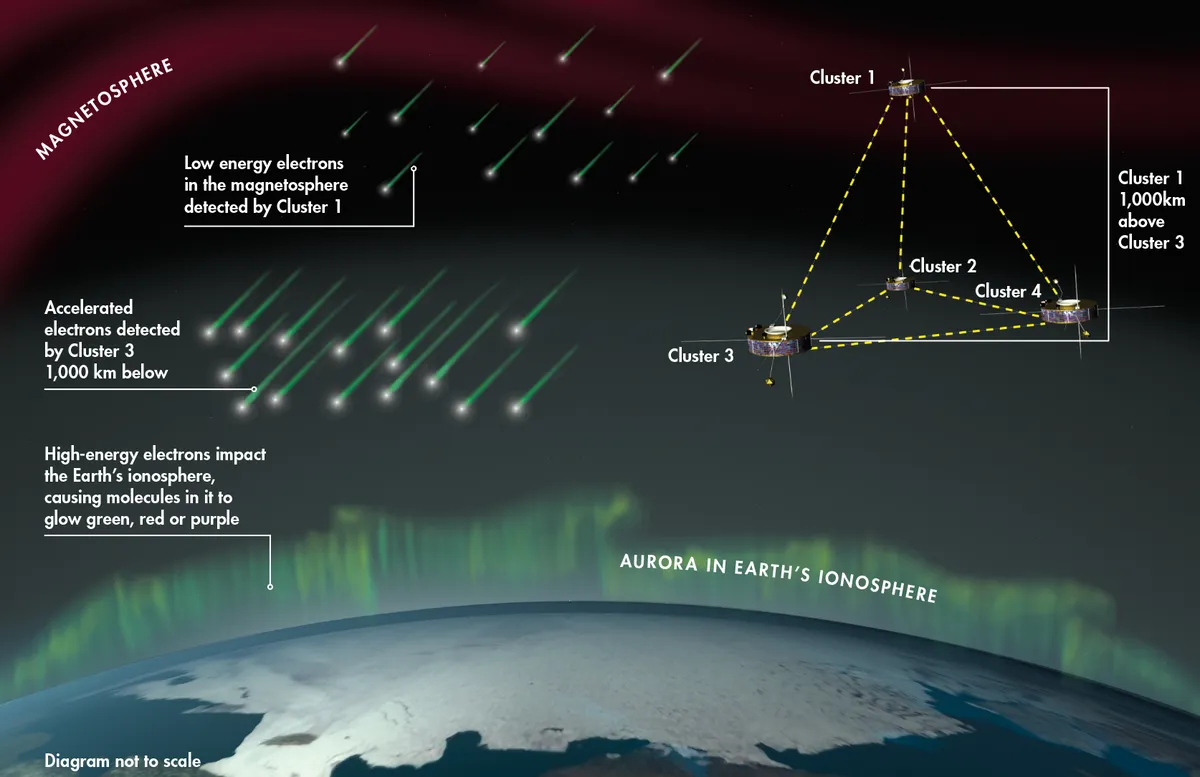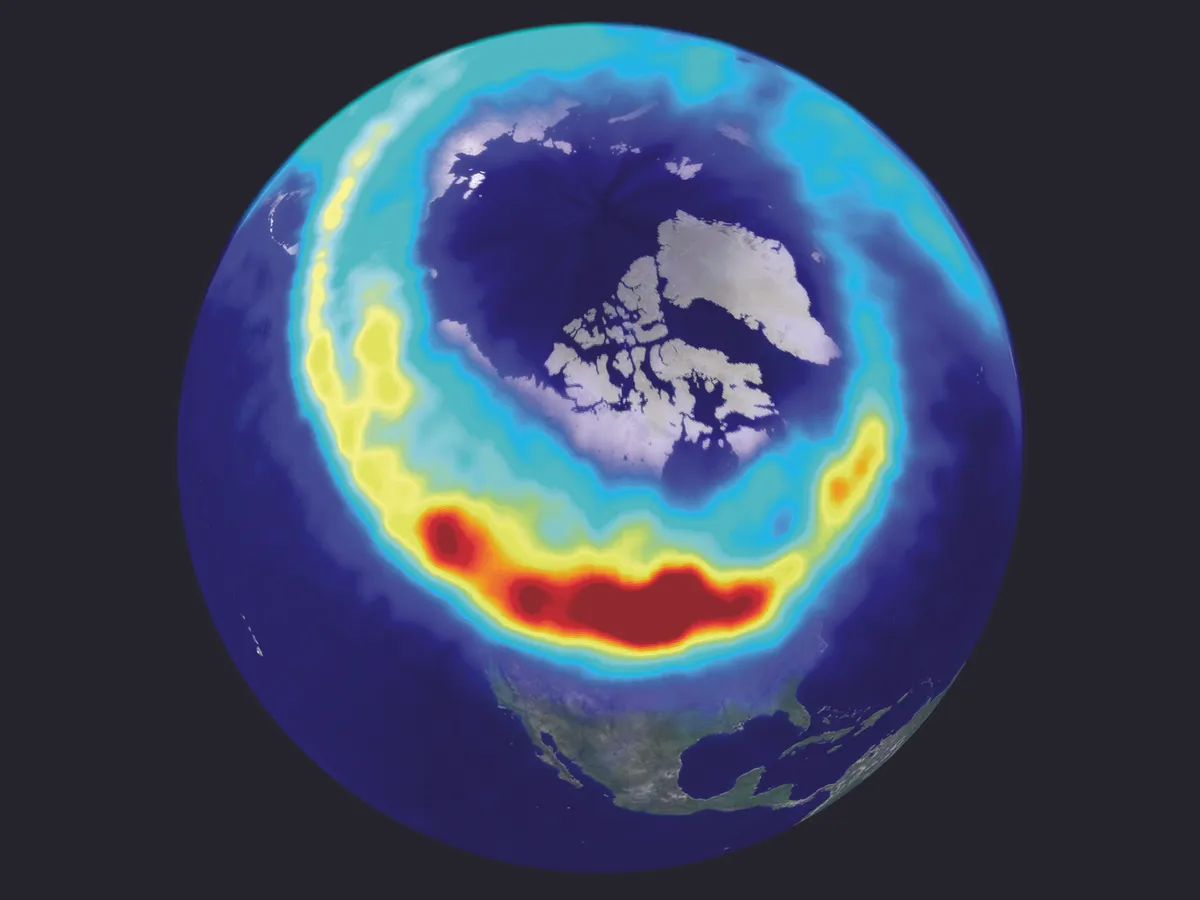A spectacular display of the Northern or Southern Lights is an incredible sight, with the night sky transformed by pulsating curtains of coloured light. Over the past 150 years, it’s become clear that these shimmering apparitions are related to solar activity.
Scientists had worked out that aurorae seemed to happen when streams of energised particles from the Sun ran into a natural force field surrounding Earth. But the actual mechanics of what causes these dramatic light shows has remained very much a mystery.
Scientists have since made a raft of discoveries about the aurora, including a breakthrough in understanding the forces involved, thanks to a flotilla of spacecraft called Cluster.
In research released at the National Astronomy Meeting 2010, the mission, led by British scientist Dr Colin Forsyth, tracked particles on their journey to penetrate the Earth’s upper atmosphere.
Other recent findings about this phenomenon include dramatic explosions of light that happen when aurorae collide, as well as a kind of anti-aurora.
The four probes that make up Cluster were launched in 2000 ago to study Earth's magnetosphere.
Dr Forsyth, of Mullard Space Sciences Laboratory (MSSL) in Surrey, led a team that used them to measure how some charged particles from the Sun got accelerated into our atmosphere.
The craft, called Rumba, Salsa, Samba and Tango, are in a triangular pyramid formation so that they can examine this in detail above Earth.
It enabled MSSL’s Plasma Electron And Currents Experiment (PEACE) to measure particles at different altitudes simultaneously, thus determining their acceleration.

Dr Forsyth’s interpretation of the data was that the electrons were accelerated by approximately 500 volts (the standard measure of an electromotive force) between the Cluster spacecraft positioned 1,000km apart.
Previous studies have shown that when particles reach the atmosphere, they have been accelerated by around 10,000 volts, so he believes the satellites were seeing only a small part of the acceleration region.
The fact that Dr Forsyth’s team were able to make their observations at all was somewhat serendipitous.
When Cluster’s satellites were launched in 2000 into their highly elliptical orbits, there was no intention to study the auroral region around the Earth; indeed the probes did not come down low enough to do so.
Instead, Cluster was designed to look at the deep magnetosphere about 120,000km out.
But the mission – originally intended to last about two years – was repeatedly extended and meanwhile the orbits changed, allowing auroral science to be done.
It’s not the first insight into the mechanisms that drive the aurora that Cluster has provided.
Among the aurora’s colourful curtains, observers remarked on an effect they named the black aurora – dark spaces between the glowing bands.
They thought these might be illusory, perhaps due to a contrast effect. However, Cluster discovered that the phenomenon is real.
It’s a type of anti-aurora, formed when conditions are the opposite of what happens to cause normal aurorae. It was observed taking on the form of dark rings, curls and blobs.
The space probes’ detailed observations revealed that the black aurora occurs in holes in the ionosphere where particles are shooting upwards into space, rather than downwards as the normal auroral particles do.
They determined that the phenomenon is very short-lived – a black aurora and its associated electric field detected by threeof the Cluster probes had vanished when the fourth probe flew by just seconds later.

In 2009, scientists in the US made another astonishing discovery in a separate investigation into the aurora.
A network of cameras in the Arctic, supporting satellites making up NASA’s THEMIS (Time History of Events and Macroscale Interactions during Substorms) mission, observed that vast curtains of the Northern Lights occasionally collide, producing spectacular bursts of light.
The collisions happen on a huge scale, so big in fact that they’re not apparent to observers. They revealed themselves when movies were assembled from individual cameras to produce the bigger picture.
The THEMIS mission’s five space probes were launched to discover why aurorae sometimes appeared to explode brilliantly in what is called a substorm.
The THEMIS spacecraft took samples of particles and measured the strength of the electromagnetic field from above, while cameras were set up across the Arctic in Alaska and Canada to photograph auroral displays from below.
Time and again, the movies revealed curtains of aurora crashing together to produce the brilliant outbursts.
Team member Larry Lyons of the University of California, Los Angeles said: “Our jaws dropped when we saw the movies for the first time. These outbursts are telling us something very fundamental about the nature of aurorae.”
The team’s results identified a common pattern of events behind the atmospheric collisions.
Each began with a broad curtain of slow-moving aurorae and a smaller knot of fast-moving aurorae that were at first widely separated.
As the slow curtain hung in place, barely moving, the smaller knot would rush in from the north, producing the collision and an eruption of light.

The researchers believe that the collisions are linked to something dramatic happening in what they call Earth’s ‘plasma tail’ – a structure made up of charged particles captured from the solar wind, millions of kilometres long, pointing away from the Sun and held together by our magnetic field.
They believe the fast-moving knot of aurora is associated with a stream of relatively lightweight plasma jetting through the plasma tail.
From the outer regions of the plasma tail, the stream moves swiftly in towards Earth and the fast knot of aurora moves in synch with it.
At the same time, the broad curtain of aurora is connected to, and fuelled by, the stationary inner boundary of the plasma tail.
When the two types of plasma converge it is seen as a collision of aurorae over the poles.
The THEMIS space probes confirmed the lightweight flows of plasma through Earth’s tail, and echoes of the material rushing through the upper atmosphere were also detected by radar stations in Alaska and Greenland.
Since the aurora is more often seen when the Sun is particularly active, the frequency of displays generally matches the 11-year solar cycle.
However, two noticeable peaks have been observed. The first occurs a year before sunspot maximum and is due to solar flare activity, while the second is the early stages of the decline in solar activity and is thought to be due to coronal hole events on the Sun.
Oddly, aurorae appear infrequently at the time of maximum sunspots, yet good displays may be seen when solar activity is at minimum.
Displays can occur at any time of night, but there are favourable times of year – the equinoxes.
Moonless nights are needed to see the fainter ones. If you want to observe a display you’ll find the aurora sections of the British Astronomical Association and the Society for Popular Astronomy a good starting point.
It is a field of stargazing that does not need a telescope. Photographing the aurora usually requires a fast ISO setting on the camera with the lens wide open, an exposure time of several seconds to a minute and a tripod to keep the camera steady.
We’ve come a long way from the primitive view that the aurora is a peep into heaven, warring tribes or dancing spirits.
The work of ground teams, together with space probes like Cluster, are ensuring that we are also coming to understand the forces that create this incredible natural light show.
How Cluster orbits Earth

Launched in 2000, these four identical probes are in a triangular pyramid formation in a large elliptical polar orbit.
Their path takes them from a distance of 19,000km to 119,000km above the Earth every 57 hours (3 to 19 times the radius of the Earth).
The inner point of the orbit was originally too high to monitor the auroral region, but as the mission has been extended, the orbit has evolved to allow the current observations to be made.
Interview

BBC Sky at Night Magazine spoke to Cluster mission specialist Dr Colin Forsyth about his findings
What is Cluster trying to observe?
The aurora is caused when streams of particles from the Sun get trapped and then accelerated through the magnetosphere.
In the past, single spacecraft have been used to study this environment, but could tell us only what was happening at the position of that spacecraft.
With the Cluster mission, we have four spacecraft flying in formation and can get 3D measurements as they fly through this region.
We already knew from previous missions that to get bright aurorae you basically have to energise particles down into the atmosphere.
With Cluster we’ve got right into the middle of this acceleration region with our four spacecraft.
We’ve been able to look at this process happening and are going to be able to study it in much more detail.
Why is it important to study and understand the aurora?
People are fascinated by aurorae. We want to know exactly the processes that cause them to work and by doing that we start to get more of a handle on how other processes work throughout the Universe.
The plasma processes that we’re studying are universal ones that will happen on other planets too.
We can already see aurorae on Jupiter and Saturn. They may be happening further out on exoplanets too, and if we understand the processes better there may be a way to look for them on distant worlds.
As far as the Earth is concerned, the aurora represents energy input from the magnetosphere into the atmosphere.
So wherever you get an aurora you are actually heating up the atmosphere a little bit.You’re driving currents and all sorts of things in the upper atmosphere.
At the moment the models we use to determine atmospheric flows, from high levels right down to lower levels like weather and so on, work at a large scale. They don’t have the smaller detail, or microphysics, in there.
If we really want to understand how the aurora and Sun affect the upper atmosphere and how this space weather can affect climate change and so on, we really have to understand the energy input properly.
That means understanding the process, which means understanding the aurora.
This article originally appeared in the July 2010 issue of BBC Sky at Night Magazine. Paul Sutherland is a freelance science journalist.